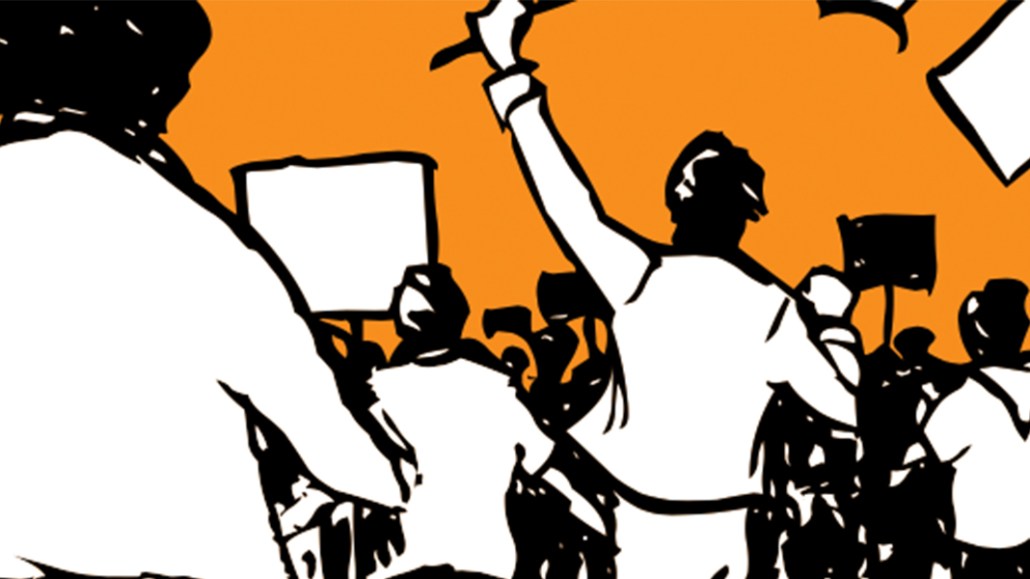As protests escalate, advertisers and media owners face a fresh crisis

U.S. advertisers and publishers had only just started to look beyond coronavirus triage mode when another crisis came hurtling into view.
The death of George Floyd, an unarmed black man who died late last month after being arrested by a white police officer, has sparked protests across the country, many of which have flared into violence between police and demonstrators. Several cities have imposed curfews and President Trump has threatened to deploy the military to suppress disorder. Conversations about police violence and racial injustice have sparked worldwide.
The fast-moving and highly fractious situation has again thrown advertiser and publishers into a state of uncertainty and fear. For many marketers, the instinct is again to go quiet and reassess how the situation unfolds, much as the approach was in the first month of coronavirus.
“Nobody was imagining we would have to be replanning for these sorts of circumstances yet again,” said Barry Lowenthal, chief executive of media agency The Media Kitchen.
The range of curfews across the country and instances of vandalism throw in other practical media planning and optimization dilemmas around whether advertising is appropriate in locations where stores aren’t open or where offering food delivery, for example, could put staff in danger.
“This is different than Covid-19 where the advice to clients was closer to ‘Keep calm and carry on’ — right now, there are bigger and deeper societal issues to address when the country is in trauma,” said Joshua Lowcock, chief digital and global brand safety officer at UM.
“Be empathetic” is the key piece of advice Lowcock is giving to clients that are still in-market. “And don’t be in-market if it puts your team members or the public at risk,” he added.
For news publishers, the latest unrest comes at an already painful time. The coronavirus crisis has triggered mass layoffs, furloughs and closures of titles following a major decline in the ad market and the expectation of a prolonged economic downturn. And while traffic to news sites soared during the first few weeks of the pandemic, some advertisers that were still spending during the period sought to actively avoid coronavirus content, or even bad news.
The current news cycle presents many keywords and categories — such as “death” and violence” — nervous advertisers might look to avoid. From May 29 through June 1, the number of pages flagged as “negative news” on contextual targeting platform Peer 39’s network was 12.9% of the overall volume, up from 10.7% in the two weeks prior to Floyd’s death. The Peer 39 negative news category includes content about crime, accidents, death, disasters, terror and war.
Daniel Avital, chief strategy officer at Cheq, a tech vendor that offers a brand safety tool that analyzes the context of the content on a page rather than keywords, said 90% of clients had requested some form of tightening of restrictions for stories related to the U.S. protests. The 10% that hadn’t requested to be excluded, had largely decided to proactively support news organizations as part of their brand safety policies, said Avital.
An early poll of GroupM clients found that close to 60% of those surveyed had actively chosen not to blanket-block news related to the unrest, but some are in discussions about whether to pause campaigns, said John Montgomery, the agency’s executive vice president of global brand safety. A source at one large U.S. news publisher said they had yet to see a major dip in advertising yield related to the current news cycle.
Even still, the possibility that premium news organizations might be penalized in covering another era defining — but ultimately negative — story in the last few days could present another major blow. In the last few days, dozens of reporters and photographers have been attacked or arrested while covering the demonstrations, according to the U.S. Press Freedom Tracker. Meanwhile, President Trump has continued to use his Twitter account to deride the press.
Tracy De Groose, executive chair of U.K. news media trade group Newsworks, said the fallout from and situation leading to Floyd’s death marks an incredibly important story that will broaden and continue to run.
“Of course there are genuine sensitivities around the context of advertising placement but I would encourage advertisers and agencies to regularly check their approach, and block lists, to ensure they are not commercially censoring the free flow of journalism around this incredibly important and evolving issue,” said De Groose.
For now, many marketers are turning to messages of support and solidarity on social media. Yet the parade of brands posting similarly worded messages against black backgrounds is somewhat similar to the initial “in these uncertain times” coronavirus response, which was quickly lampooned for its sameness and reliance on platitudes rather than pledging helpful action or financial support.
“Brands just need to do better,” said Christopher Kenna, CEO of diversity focused media network Brand Advance. “There’s no right or wrong answer [in engaging with the current situation] as long as you can say hand on heart that ‘this is authentic for us’ and everything you do around that feeds into that authenticity.”
More in Media

No playbook, just pressure: Publishers eye the rise of agentic browsers
For the bulk of publishers, Google is, as ever, the one to watch. It’s already got agentic features within its Chrome browser, but that’s the tip of the iceberg, some say.

The biggest SEO lessons in 2025 for publishers
KPIs are changing, more AI search data is becoming available, and publishers are looking beyond search to grow their audiences and revenue.

Digiday’s comprehensive guide to what’s in and out for publishers in 2026
Adaptability stopped being a nice-to-have for publishers years ago; it became a survival skill. Here’s a look at Digiday’s guide to what’s in and out for 2026.








